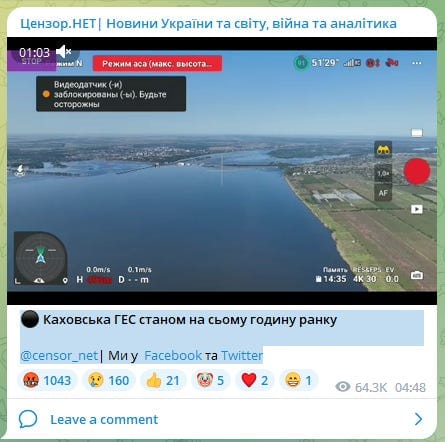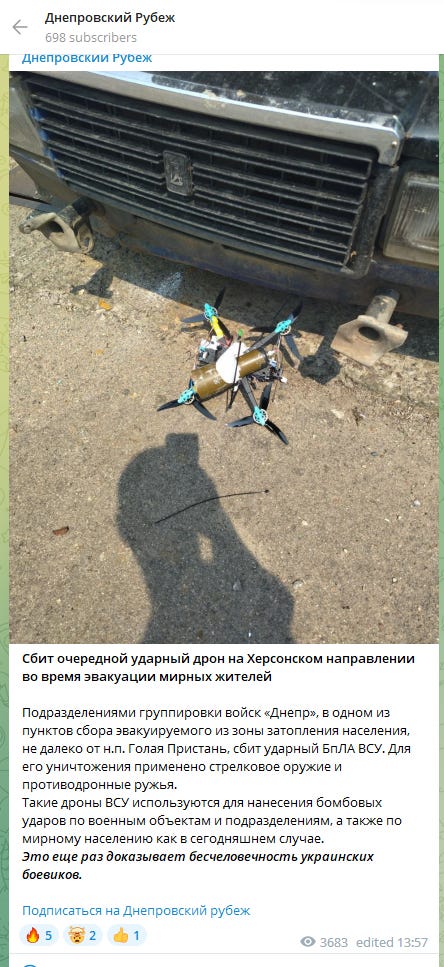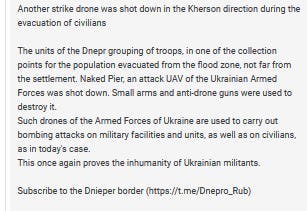Disaster Response, Drones and the Nova Kakhovka Dam Collapse
Drones are helping responders rescue people and assess the scale of the Kherson flooding - but their presence comes with risk.

I started my career in drones looking at how little flying robots with cameras on them might be put to use in humanitarian aid. Now, both Ukraine and Russia are scrambling to make use of drone technology as they respond to the horrifying Nova Kakhovka dam collapse in Ukraine’s Kherson area - which means that, unfortunately, two of my areas of professional drone interest are overlapping. With that in mind, here’s my take on how drones seem to be figuring into the flooding disaster response so far.
In Kherson right now, thousands of homes are flooded, many people have been trapped by the rising floodwaters, and volunteers on both the Ukrainian and Russian sides of the conflict are trying to get rescue boats, food, and water out to impacted people in an active war zone (although Ukraine says that Russians in occupied areas have been hindering evacuation efforts, too).
And there are a lot of small drones in the air.
Primarily, both Ukrainians and Russians appear to be using drones for what they’re best at: giving people situational awareness, on a much faster time-table than is possible with satellite imagery, and with less risk to human life than is involved with flying a crewed aircraft.
On June 6th, soon after it became clear that the Nova Kakhovka dam was done for, drone videos and photos showing the massive extent of the flooding swiftly began to appear on social media.
Here’s one shot early in the morning:
And here’s one from later that day:

As of today, 6/8/2023, drone video that appears to show the extent of the damage to the hydroelectric station from a very close-up perspective has been released on social media. If it’s authentic, it’s video evidence that will be of great interest to both Ukraine and to Russia, who are currently both blaming one another for the dam collapse.
Drones are also already coming into play to help authorities assess another major risk: landmines, displaced by the surging flood waters and now, presumably, floating off to places unknown.
While true drone-based mine detection tech is still largely experimental (and some of those experiments are being run right now in Ukraine), drones currently are an invaluable tool for helping aid workers swiftly get a handle on minefield flooding. The Guardian has already released drone footage of one such flooded area in Southern Ukraine, and more will doubtless follow in the days to come.
The most famous disaster-drone story to come out of the floods so far is that of “Santa,” the call-sign alias used by an Ukrainian State Border Guard Service Member who repurposed the after-market explosives dropper device on his DJI Mavic drone to provide small quantities of food, water, and “encouraging messages” to trapped people.
While Santa’s efforts don’t represent a larger-scale push to use drones to deliver supplies to disaster- impacted people in Kherson - I’ve seen no other examples so far - it’s a wonderful example of how versatile both drones and the people who fly them can be. And it’s also a nice story amidst a sea of horrible stories. Which is very valuable thing.
The family trapped in their attic in the video above were ultimately rescued, and go a chance to thank “Santa” themselves.
And then, there’s the attacks on relief workers who are trying to evacuate civilians from the Kherson area.
As I write this on 6/8/2023, Ukrainians claim that Russians continue to shell evacuation and rescue efforts, statements that Volodymyr Zelenskyy backed up in public remarks.

There’s video of the shelling here:
Meanwhile, a Russian source also claimed that Ukrainians attacked their own relief efforts with a small kamikaze drone, and a Kremlin spokesperson repeated the claims to journalists in a Thursday phone call (per CNN).

Another such incident is alleged by Russians here.

An English translation of the above:

These attacks on people trying to render aid to flood victims brings me to a very important topic: how drones might put relief workers at risk, and how these risks differ from those of the past.
I’ve long written about - and worried about - what might happen when aid workers and volunteers try to use drones to assist in relief efforts in an active war zone. As everything I’ve posted above (hopefully) makes crystal-clear, this is no longer a theoretical scenario.
The Kherson flood relief efforts may very well be the first truly unambiguous case of small consumer drones being used in a hot war zone to directly assist with civilian rescue efforts , at least as far as I know.
In pieces I’ve written for the ICRC and for other outlets, I’ve pointed out that small drones all look pretty much alike in the air, and we have few meaningful ways to differentiate between an aid worker drone and those flown by combatants. The alikeness of small consumer drones creates issues under international humanitarian law, as its principle of distinction hinges upon the possibility of being able to distinguish between protected people and objects, and those that aren’t.
Things are further complicated by the fact that, as the story of Santa above illustrates, it’s pretty fair to assume that many of the drones assisting with civilian relief efforts in Kherson right now are the exact same drones that combatants are using to fight elsewhere - and of course, many of the people flying them are likely active-duty combatants themselves.
Beyond drone mistaken identity, it’s also true that the drone’s mere presence creates security risks for volunteers and civilians.
Small drones, as most every Ukraine watcher knows by now, can easily be detected by electronic warfare weapons if they aren’t modified before they take to the air. It’s eminently possible that a volunteer flying a poorly-secured drone to look for people in need of rescue could accidentally paint a big target on the backs of the very civilians they’re trying to help. In 2023, it’s absolutely crucial that everyone who flies a drone anywhere near a war zone truly understands these risks.
As a friend of mine pointed out to me today, DJI drone pilots flying to assist relief efforts near Kherson may also run into geofencing altitude limits - which DJI places on all global airports - in the wide radius around the Kherson International Airport. While the airport is no longer in use, the restriction remains in place.
Although DJI does have a standard procedure that pilots can use to get these limits lifted for their aircraft during times of disaster, it’s also true that DJI is not exactly thrilled about the extensive use of their products for military purposes during the War in Ukraine. It’s unclear what the company might do if a request to lift the limits does come in.

I don’t have all the answers here, but I do know this.
It’s high time for the humanitarian aid community to do more work around defining where small consumer drones fit into aid, and better ways for aid workers to keep themselves safe in our small-drone filled future.
